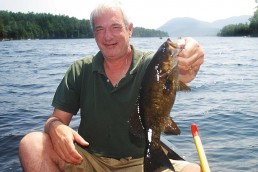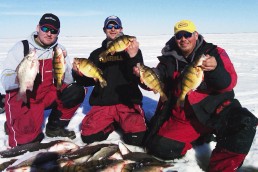Perch Fishing Michigan in 2016
SHARE THIS POST
The cool winds of early January chilled my neck. At this moment, I wished for some type of windbreak. Before the wind chill could take its effect though, the perch started to hit. Nothing warms you up faster than catching fish, and a tasty perch dinner is hard to beat. Perch fishing is not complicated once they are found; the challenge is locating the fish.
Perch need to eat so find the forage. This could be minnows, plankton or small larvae. Second, they love flats. Find the food source and the perch will be there. Any changes on the bottom, from rocks to sand or weeds to muck, are all holding places.
This might be a shallow food shelf in 10 feet of water or a flat in 30 to 50 feet of water. Perch like the deep-water flats and are often found close to the edge of the last drop-off.
Most anglers use minnows, spikes, wigglers or a waxworm on a teardrop or a colored number 6 hook. Small minnows in the 2-inch range or a couple of colored spikes work well. Minnows are often hooked lightly on a small wire hook, while the spikes are used on a teardrop. Popular teardrops include the Marmooska, K & E Moon Glows and the Uncle Josh Ice Flecks. These baits work wonders when jigged slowly with a piece of meat.
Jigging spoons have their place when perch fishing. The most popular choices include Normark Jigging Rapala, Custom Jig & Spins Stinger or the spoons from Bait Rigs and Lindy Tackle. The rocking side-to-side action really entices golden perch.
Bright colors are my favorite—give them something bright and flashy and perch will hammer it. We experiment with a single hook or a treble hook. A long shank single hook works great, but a very small treble hook will work as well. The standard treble hook is a bit larger than you need for perch.
The 1/8- to 1/4-ounce spoons in a bright color attracts the perch like a magnet. A slow lift and drop motion while keeping the spoon within 2 feet of the bottom is the most effective presentation. Start with a slow lift and gradually get into a faster snap of the rod tip. The fish will tell you what type of retrieve is best for that given day, but usually you can start slow.
At first ice you can get lucky if you find any green weeds. This shallow water fishery is normally best right at first ice and once again at last ice.
As winter takes hold anglers will find more perch in the deep water. Anglers need to move around in the deep hole until the fish are found. Once located, a bucket of perch can easily be caught from one deep-water location.
Lake Goegebic
The largest lake in the Upper Peninsula is well known for its jumbo perch. Master angler perch come out of this lake with regularity. Scanning the DNR Master Angler List will quickly show the success of this lake.
Gogebic is a long, fairly shallow and flat. The center, and basically its entire length, averages around 20 to 25 feet of depth. There are a few deep holes, but don’t expect anything real deep.
Tons of fish cribs were installed to provide additional cover for the fish. Also, millions of minnows were planted because there was a shortage of food for the walleyes.
Most of the fish cribs were placed in depths between 15 to 20 feet were the breakline is located. The majority of the cribs are located on the west side of the lake. Purchasing a lake map from resorts or bait shops will pinpoint the exact locations.
A good starting place would be Porcupine Point on the northeast end, just off of East Shore Road and straight across from the Ontonagon County Park. Much of this area is less than 15 feet with many irregular changes in bottom depths and structure.
A fish crib is located just north of the point near the center of the lake. Just south is one of the deepest holes in the lake. The depth hits 35 feet and is a good summer location for perch and walleyes. Alligator Point on the southwest end has plenty of rocks. This area has a 25-foot hole just off the rock piles. Summertime perch, bass or walleyes can easily end up on your line.
Three public launches are located here. One is north by Little Bear Bay, one south at the State River mouth and Ice House Bay and the last, straight across the lake at Six Mile Bay. This is another shallow-water area and often very good early in the year. Most of the depth is less than 10 feet with a fair amount in the 5- to 6-foot range. Perch and walleyes are fond of this area. Once again, be prepared for battle with the freshwater “barracuda.”
Six Mile Bay and Montgomery Point is a productive location all season. Underwater points and good bottom structure are drawing cards. Add to this the shallow bay with a deep hole in front of the public launch, and you have a dandy location to fish.
Are you enjoying this post?
You can be among the first to get the latest info on where to go, what to use and how to use it!
Trout Brook Creek, just south of this location, is not large, but can be productive all season. Good bottom structure is located in this region, drawing bass, perch and walleyes.
Crystal Lake perch
This is the year boat anglers dream of: Big, deep Crystal Lake has not frozen over and may not this winter. With depths hitting 160 feet, it takes sustained cold snap to freeze over.
The two biggest challenges are locating a school with the right-sized perch and the boat launches not freezing over.
This has become a very popular ice fishing lake for perch, trout, smelt and whitefish. Successful anglers spend a fair amount of time with their eyes peeled to a graph. Schools of perch are fairly easy to locate and often school-up by size.
Most concentrate in depths of 60 to 75 feet. Covering nearly 10,000 acres, it would appear that finding a perch is like finding a needle in a haystack. Luckily, a few general locations will get you started.
Beulah is a village located on the east shoreline. Anglers fish here more than anywhere else on the lake. A public launch is located just south of Beulah off of U.S. 31.
An excellent location is north of Railroad Point off of Crystal Lake Road. This is on the south shoreline, a few miles west of Beulah. The depth drops off quickly from 50 to 70 feet.
A third winter location is along the west shoreline off of the M-22. Once again, the depth drops fast into the deep water.
Call the Back Cast Fly Shop at 231-882-5222.
Muskegon Lake perch
The rod bent over and felt like a good fish; after a short battle, two nice perch came aboard … Starting the day with a double always gets the blood flowing. Lake Michigan can be hit or miss—depending on the weather—for locating the school.
Muskegon Lake consistently produces fish. Some days you hit the foot-long perch and other days the perch average 8 inches.
Ken Clark, guide and owner of fishmascharters.com likes White Lake. On both White and Muskegon lakes, perch move into the deep water from Lake Michigan. This is often in depths of 40 to 60 feet. On Gun and Gull Lake, try the weed beds and then search out the deep water holes.
Snug Harbor is located at the northwest corner of the lake and borders the State Park.
“Snug Harbor at times has excellent perch fishing,” says Mary Conran, of Snug Harbor (231-744-3440). When the perch are in shallow to spawn, Snug Harbor is an excellent location to fish.
On the east side of the lake anglers should consider Saginaw Bay, Lake St. Clair and Lake Erie. A few of the best inland lakes would include my favorites, Freemont, Hubbard and Higgins lakes. On some of the larger lakes we run our boats into February. Other smaller lakes we are (were) ice fishing by the first week of January. Once the ice leaves search out the shallow water areas that have old weeds or reed beds. Perch will flock to the warmer waters where there is some type of debris to feed and spawn.
MWO
SHARE THIS POST
Did you enjoy this post?
You can be among the first to get the latest info on where to go, what to use and how to use it!
Jack Payne
Jack Payne is an accomplished angler and hunter who enjoys teaching others as much as learning from others. Seminar speaker, outdoor photography enthusiast, hunter safety instructor and volunteer at many events for both kids and adults as an instructor.



